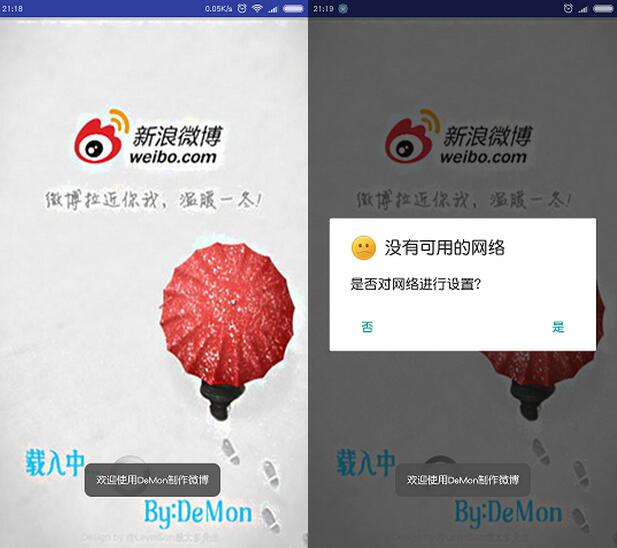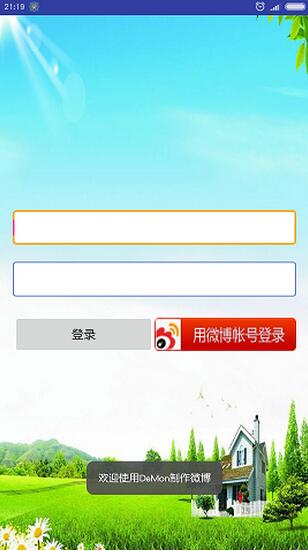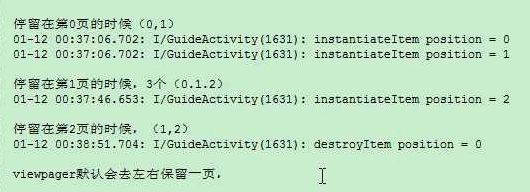編輯:關於Android編程
本文為大家分享了Android模仿新浪微博啟動界面&登陸界面的具體實現代碼,供大家參考,具體內容如下
啟動界面
主要有兩個功能:
1.加載啟動動畫
2.判斷網絡,有者直接進入登陸界面,否則去設置網絡
代碼較簡單,主要采用AlphaAnimation()方法和動畫監聽器,使一張圖片產生漸變動畫。在動畫啟動的時候判斷網絡,動畫結束時完成判斷並進入登陸界面。
/**
* Created by D&LL on 2016/5/25.
* 初始頁面加載界面
*/
public class SplashActivity extends Activity {
@Override
protected void onCreate(Bundle savedInstanceState) {
super.onCreate(savedInstanceState);
setContentView(R.layout.splash);
ImageView splashimage = (ImageView) findViewById(R.id.splashimage);
//透明度漸變動畫
AlphaAnimation animation = new AlphaAnimation(0.1f, 1.0f);
//設置動畫時長
animation.setDuration(3000);
//將組件和動畫進行關聯
splashimage.setAnimation(animation);
animation.setAnimationListener(new Animation.AnimationListener() {
//動畫啟動執行
@Override
public void onAnimationStart(Animation animation) {
Toast.makeText(SplashActivity.this, "歡迎使用DeMon制作微博", Toast.LENGTH_LONG).show();
//檢查並網絡的方法
Tools.checkNetWork(SplashActivity.this);
}
//動畫結束執行
@Override
public void onAnimationEnd(Animation animation) {
Intent intent = new Intent(SplashActivity.this, LoginActivity.class);
startActivity(intent);
finish();
}
//動畫重復執行
@Override
public void onAnimationRepeat(Animation animation) {
}
});
}
使用ConnectivityManager獲取系統的連接服務,然後獲取代表聯網狀態的NetWorkInfo對象,獲取網絡的連接情況,如果沒有網絡則生成一個AlertDialog引導進行網絡設置。該方法位於Tools.java中。
/**
* 設置網絡
*
* @param context
*/
public static void checkNetWork(final SplashActivity context) {
if (!NetWorkStatus(context)) {
TextView msg = new TextView(context);
msg.setText("請設置網絡!");
AlertDialog.Builder b = new AlertDialog.Builder(context).
setIcon(R.drawable.notnet)
.setTitle("沒有可用的網絡")
.setMessage("是否對網絡進行設置?");
b.setPositiveButton("是", new DialogInterface.OnClickListener() {
public void onClick(DialogInterface dialog, int whichButton) {
//跳轉到設置網絡界面
context.startActivity(new Intent(Settings.ACTION_SETTINGS));
}
}).setNeutralButton("否", new DialogInterface.OnClickListener() {
public void onClick(DialogInterface dialog, int whichButton) {
dialog.cancel();
context.finish();
}
}).create().show();
}
}
/**
* 判斷網絡狀態
*/
public static boolean NetWorkStatus(Context context) {
//獲取系統的連接服務
ConnectivityManager connect = (ConnectivityManager) context.getSystemService(Context
.CONNECTIVITY_SERVICE);
if (connect == null) {
return false;
} else {
// 獲取代表聯網狀態的NetWorkInfo對象,獲取網絡的連接情況
NetworkInfo[] infos = connect.getAllNetworkInfo();
if (infos != null) {
for (NetworkInfo network : infos) {
if (network.getState() == NetworkInfo.State.CONNECTED) {
return true;
}
}
}
}
return false;
}
SplashActivity的布局文件splash.xml
<?xml version="1.0" encoding="utf-8"?> <RelativeLayout xmlns:android="http://schemas.android.com/apk/res/android" android:layout_width="match_parent" android:layout_height="match_parent"> <ImageView android:id="@+id/splashimage" android:layout_width="match_parent" android:layout_height="match_parent" android:scaleType="fitXY" android:src="@drawable/splashimage"/> <ProgressBar android:layout_width="wrap_content" android:layout_height="wrap_content" android:layout_alignParentBottom="true" android:layout_alignParentStart="true" android:layout_gravity="center" android:layout_marginBottom="64dp" android:layout_marginStart="130dp"> </ProgressBar> </RelativeLayout>

登陸界面
此界面只有幾個按鈕,故合在一條博客裡。
微博按鈕觸發進入到到授權界面
public class LoginActivity extends Activity {
private Button sinalogin;
@Override
protected void onCreate(Bundle savedInstanceState) {
super.onCreate(savedInstanceState);
setContentView(R.layout.login);
sinalogin = (Button) findViewById(R.id.sinalogin);
sinalogin.setOnClickListener(new View.OnClickListener() {
@Override
public void onClick(View v) {
Intent intent = new Intent(LoginActivity.this, OAuthActivity.class);
startActivity(intent);
LoginActivity.this.finish();
}
});
}
}
布局文件login.xml兩個自定義樣式的EditText,一個普通按鈕(此處純粹擺設)。只有微博登陸按鈕有用。
<?xml version="1.0" encoding="utf-8"?> <LinearLayout xmlns:android="http://schemas.android.com/apk/res/android" android:layout_width="match_parent" android:layout_height="match_parent" android:background="@drawable/background" android:gravity="center_vertical" android:orientation="vertical" android:paddingBottom="@dimen/activity_vertical_margin" android:paddingLeft="@dimen/activity_horizontal_margin" android:paddingRight="@dimen/activity_horizontal_margin" android:paddingTop="@dimen/activity_vertical_margin"> <EditText android:id="@+id/username" android:layout_width="match_parent" android:layout_height="40dip" android:background="@drawable/bg_edittext" android:ems="10" android:inputType="textPersonName"> </EditText> <EditText android:id="@+id/passworld" android:layout_width="match_parent" android:layout_height="40dip" android:layout_marginTop="20dip" android:background="@drawable/bg_edittext" android:ems="10" android:inputType="textPassword"/> <LinearLayout android:layout_width="fill_parent" android:layout_height="wrap_content" android:orientation="horizontal"> <Button android:id="@+id/login" android:layout_width="200dp" android:layout_height="wrap_content" android:layout_marginTop="20dip" android:layout_weight="1" android:text="登錄"/> <Button android:id="@+id/sinalogin" android:layout_width="200dp" android:layout_height="38dp" android:layout_marginTop="20dip" android:layout_weight="1" android:background="@drawable/weibologin"/> </LinearLayout> </LinearLayout>

以上就是本文的全部內容,希望對大家的學習有所幫助,也希望大家多多支持本站。
 Android開發----------- 手電筒改進版本
Android開發----------- 手電筒改進版本
在之前的基礎上 在 res 文件夾下面: 添加一個 drawable/local_me.xml localme_cml 主程序: p
 Android項目-智慧北京:02(三種技術設計主頁面及源碼分析點擊事件傳遞的機制及Json數據傳遞的使用)
Android項目-智慧北京:02(三種技術設計主頁面及源碼分析點擊事件傳遞的機制及Json數據傳遞的使用)
演示ViewPager的預加載功能Android ViewPager 的預加載android新引入的Fragment加入了Viewpager這樣的一個組件。至於該控件的
 Android學習筆記032之數據存儲—文件存儲讀取
Android學習筆記032之數據存儲—文件存儲讀取
我們知道,在AndroidOS中,提供了五中數據存儲方式,分別是:ContentProvider存儲、文件存儲、SharedPreference存儲、SQLite數據庫存
 Android Training學習筆記之適配不同的設備
Android Training學習筆記之適配不同的設備
Android是一個開源的開放的操作系統,世界上的任何人都可以基於這個系統進行適合自己的定制活動。Android的這樣一個特點使得android世界的碎片化很嚴重,形形色